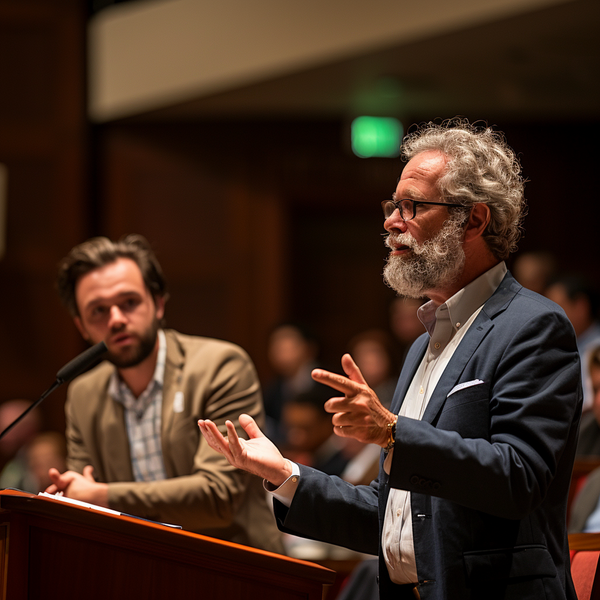Transforming Faculty Presentations: Tech-infused Pedagogy for Student Success
Empower faculty with tech-driven strategies to create engaging presentations for students. Our process segments content, refines narration, and leverages AI like ChatGPT & MidJourney to optimize slides. The result? Enhanced, visually appealing presentations that boost learning.

- Time: 4:00 pm - 4:15 pm
- Track: Emerging Education Technologies and Innovations
- Location: Summit 8
- Presenters:
Lani Draper, Texas A&M University-College Station
Gerry Pedraza, Texas A&M University-College Station

We have created a collection of Python scripts created to work together to streamline and enhance the faculty presentation creation workflow in several ways, ultimately improving student success. These include algorithms try to mimic some of the repetitive human thought processes that we commonly use to polish educational content. I have named this program Transcriptto, as it refers to the starting point of content creation... A lecture transcript that will be processed and converted to... Hence the name Transcript -> to... So a processed transcript can be turned into: A polished lecture, quiz questions, discussion questions, a summary, an outline, and slides; all using customizable prompts via a text-based configuration file that anyone can edit easily.
Example of the Output
We initially recorded some ideas over this presentation in a meeting and here are the results. This recording was treated not as a meeting but as it would have been a lecture.
--- Topical Segment 1 (~Time: 15 min & 24 sec @ 115 WPM) ---
Title: Leveraging Artificial Intelligence (AI): Enhancing Lecture Transcription and Learning Object Construction for E-Learning Courses
Consider this scenario: You are collaborating with a professor who excels in delivering in-person lectures. However, the instruction slides he typically uses may not be visually engaging, and he tends to digress. You are tasked with assisting him in transitioning his course to an online version effectively.
The professor records the lecture using 5-10 slides every hour, resulting in overstuffed, static slides and a visual experience that lacks engagement. Recording the professor on camera brings its challenges, especially when professors become self-conscious about their image, resulting in more frequent stopping and re-recording. Research shows that talking head videos have minimal impact on learning and engagement.
So, what is the solution? Our approach is to utilize the professor's expertise as a starting point, transforming it into an engaging online learning experience. This method involves using artificial intelligence (AI) to transcribe, add context, and streamline the content of the professor's lecture. It enhances the original lecture's clarity, relevance, and structure, minimizing redundancies and off-topic digressions. Importantly, it's not about replacing human instruction with AI but enhancing it through the AI's capabilities.
The AI system first streamlines the lecture, and it subsequently identifies key topics, which will help break up the content into digestible chunks. The prompts guiding the AI in doing so can be customized based on the professor's style and the course context.
Next, the system works on breaking the lecture into smaller segments, ideally not exceeding 15-minutes each. It identifies ideal breakpoints and creates compelling titles for each segment based on the content discussed. The system then formulates an introduction and learning objectives for each segment, which are derived directly from the segment's content.
Now comes the creation of the instructional materials. The AI generates an outline with the rule of a slide change, at least once in every two-minute span. This improves visual engagement and prevents singular slides from being overloaded with text. The AI ensures that slide content is concise and geared toward student comprehension. The professor's critical talking points, as transcribed by the AI, are added in a comments section of the outline.
To further facilitate learning and reinforce key concepts, the AI system generates two activities for each video, at least five end-of-video quiz questions, a discussion question, and a 'wrap-up' assignment tying together the different topics explored in each session.
The lecture segments, along with their accompanying materials, are then reviewed by the professor for contextual accuracy, relevance, and alignment with their teaching style. They provide feedback, which the instructional designer utilizes to modify and finalize the materials.
Further, when the materials have been approved and finalized, the professor has two options to deliver the online course. They can either record the course based on the new, streamlined script and slides or utilize a synthesized version of their voice (text-to-speech) to do the same.
This method revolutionizes the online teaching preparation process. It streamlines the transformation from traditional lectures into engaging online modules, and it places a high priority on student comprehension, making the process a win-win solution for both professors and students.
--- Topical Segment 1: Learning Objects ---
--- Lecturette 1: Leveraging Artificial Intelligence (AI): Enhancing Lecture Transcription and Learning Object Construction for E-Learning Courses ---
Objectives:
1. Appraise a lecture transcription's efficiency using an AI solution.
2. Differentiate the benefits of AI over traditional methods in lecture transcription and learning object creations.
3. Implement the use of AI for transcription, context addition, and streamlining lecture content.
4. Configure the AI system to identify key topics and break lecture into smaller segments.
5. Apply the use of AI technology to improve student comprehension and engagement in online courses.
Discussion Questions:
1. How does the AI system enhance the traditional lecture for online instruction?
2. Can you explain how crucial talking points are identified and incorporated into the modified lecture structure?
Quiz Questions:
1. Which of the following is NOT an advantage to using AI for lecture transcription?
A. Eliminates off-topic digressions from professors
B. Automatically streamlines lecture content
C. Identifies key topics from the lecture
D. Replaces the need for a human professor @
2. Lecture segments created by the AI should ideally not exceed:
A. 5 minutes
B. 10 minutes
C. 15 minutes @
D. 20 minutes
3. In the slide creation, what is the rule regarding slide changes?
A. Slide change after every minute
B. Slide change at least once in every two-minute span @
C. Slide change after every five minutes
D. No specified time for slide change
4. What does the AI do to ensure slide content enhances student comprehension?
A. Fills slides with as much text as possible
B. Ensures content is concise @
C. Adds flashy animations
D. Utilizes complex vocabulary
5. After the AI system has created the instructional materials, what is the next step in the process?
A. Materials are immediately used for teaching
B. The professor reviews materials for accuracy and relevance @
C. Materials are sent to students for review
D. Materials are discarded
Assignment:
Using the AI tool discussed in the lecture, transcribe a 30-minute lecture into segments, develop an outline for slide creation, and form questions for each segment. Review your work comparing it with the original lecture, and note down areas where the AI tool improved the content and where you see a need to manually intervene.
Summary:
The AI system revolutionizes the lecture transcription process by streamlining content, adding context, identifying key topics, and splitting the lecture into manageable segments. This AI-enhanced, student-centric approach is essential for delivering effective online instruction. The AI tool proposed here not only assists in transforming traditional lectures into engaging online modules, focusing on student comprehension, but also facilitates professors with the creation of visually engaging slides, questions, and assignments. By utilizing this approach, we strive towards an improved teaching and learning experience in the online instructional design context.




